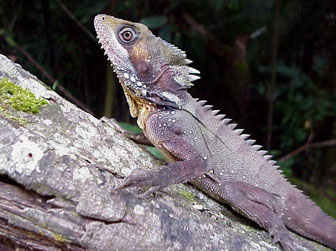Global Warming Threatens Australia’s Tropical Biodiversity
Global Warming Threatens Australia’s Tropical Biodiversity
Earthwatch Institute
July 25, 2006
Global climate change will pose serious challenges for wildlife populations around the world in the coming decades. The findings of Dr. Stephen Williams (Centre for Tropical Biodiversity & Climate Change, James Cook University) suggest that endemic wildlife populations in Australia’s Wet Tropics World Heritage Area will be particularly vulnerable to the local warming trend.

BOYD FOREST DRAGON. Photo: Dr. Stephen Williams, James Cook University, www.earthwatch.org Global warming may threaten rainforest biodiversity in Australia’s Wet Tropics in Queensland, because of the limited territories of so many creatures,. Earthwatch-sponsored researchers find. The Boyd forest dragon is one of the inhabitants of the Atherton Tablelands rain forests.
|
In a new publication, Vertebrates of the Wet Tropics Rainforests of Australia: Species Distributions and Biodiversity, Williams presents 15 years of data on the ranges of diverse birds, mammals, amphibians, and reptiles in the Wet Tropics. This encyclopedic publication clearly illustrates what this hotspot of biodiversity has to lose if current trends of global warming persist.
“There is a common, though incorrect, perception that the impacts of climate change will be worse in temperate regions than in the tropics,” said Williams, principal investigator of the Earthwatch-supported Climate Change in the Rainforest project. “Global warming can have a particularly strong impact on mountainous regions like Australia’s Wet Tropics, where the mountaintops and higher tablelands exist as cool islands in a sea of warmer climates. Almost all plants and animals unique to this region are adapted to these cooler uplands.”
Williams states that climate change in the Wet Tropics will likely result in species ranges shifting up mountains, to maintain their habitat needs. However, the mountains are not very high and many animals are already restricted to the mountaintops. There is no room for latitudinal movement as there is no rainforest for hundreds of kilometers to the north or south.
Approximately 350 species of vertebrates occur in the rainforests of the Wet Tropics bioregion, a series of mountain ranges covering approximately 1.8 million hectares, of which about 1 million hectares is rainforest.
In Williams’ report, he presents distribution maps for 177 species of Wet Tropics vertebrates, based on a combination of bioclimatic modeling, habitat preferences, biogeographic distributions, and expert knowledge. He also includes 12 species richness maps, based on overlaid distribution maps, and a comprehensive species list of all vertebrates in the Wet Tropics bioregion, with information on the conservation status, range size, and habitat specialization.
Williams was coauthor of a 2004 paper in Nature, which predicted that as many as one third of all species in the world may be destined for extinction if climate trends continue for the next 50 years. This paper followed a 2003 cover story in Proceedings of the Royal Society Lond, demonstrating the potential role of climate change on extinctions in the Wet Tropics. His vertebrate atlas for the Wet Tropics builds on these findings, giving conservation professionals the raw data on species distributions to base future management decisions on.
Earthwatch volunteers have helped Williams and his research team collect data on vertebrate species ranges in the Wet Tropics for three years, contributing to this latest publication. Using a variety of methods, from combing tropical streams to spotlighting for nocturnal animals, they sampled the abundance of birds, reptiles, mammals, frogs, plants, and insects at 200-meter elevation intervals.
“The relative resilience of a species in the face of climate change will depend on its ability to adapt within constraints such as habitat connectivity,” said Williams. “It is imperative to understand the patterns and processes of the rainforest ecosystem in order to allow effective conservation management. Knowing which species occur in any given area is a basic, but vitally important, piece of information.”
Earthwatch Institute is a global volunteer organization that supports scientific field research by offering members of the public unique opportunities to work alongside leading field scientists and researchers. Earthwatch’s mission is to engage people worldwide in scientific field research and education to promote the understanding and action necessary for a sustainable environment. The year 2006 marks Earthwatch’s 35th anniversary.
For more information, see Williams, S. E. (2006). Vertebrates of the Wet Tropics Rainforests of Australia: Species Distributions and Biodiversity. Cooperative Research Centre for Tropical Rainforest Ecology and Management. Rainforest CRC, Cairns, Australia (282 pp.) May 2006.
See also: Williams S.E., Bolitho, E. E. & Fox, S. (2003). Climate change in Australian tropical rainforests: an impending environmental catastrophe. Proceedings of the Royal Society Lond. B. 270:1887-1892.
Find more information on how to volunteer on Climate Change in the Rainforest at: http://www.earthwatch.org/expeditions/williams.html
This is a modified news release from the Earthwatch Institute.













